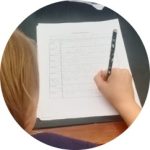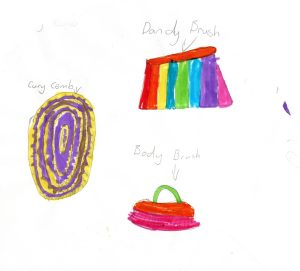8 How to Groom a Horse
Kylie Taylor
This chapter describes a multimodal text created with a child in Year 2.
CONNECTIONS TO THE AUSTRALIAN CURRICULUM
Year 2 English
Literacy:
- ACELY1665 – Discuss different texts on a similar topic, identifying similarities and differences between the texts.
- ACELY1666 – Listen for specific purposes and information, including instructions, and extend students’ own and others’ ideas in discussions
- ACELY1667 – Rehearse and deliver short presentations on familiar and new topics
- ACELY1668- Identify the audience of imaginative, informative and persuasive texts
- ACELY1669 – Read less predictable texts with phrasing and fluency by combining contextual, semantic, grammatical and phonic knowledge using text processing strategies, for example monitoring meaning, predicting, rereading and self-correcting
- ACELY1671 – Create short imaginative, informative and persuasive texts using growing knowledge of text structures and language features for familiar and some less familiar audiences, selecting print and multimodal elements appropriate to the audience and purpose
- ACELY1672 – Re-read and edit text for spelling, sentence-boundary punctuation and text structure
- ACELY1673 – Write legibly and with growing fluency using unjoined upper case and lower case letters
- ACELY1674 – Construct texts featuring print, visual and audio elements using software, including word processing programs (Australian Curriculum, Assessment and Reporting Authority [ACARA], n. d.).
Teaching Strategies and Theories

The teaching strategies I used were based on Multiliteracy Pedagogy as described in Fellowes & Oakley (2019), Freebody & Luke’s (1990) Socio-cultural Literacy perspective and Vygotsky’s Sociocultural Theory and scaffolding (Fellowes & Oakley, 2019).
I followed the Gradual Release of Responsibility approach including modelled, guided and independent reading (Fellowes & Oakley, 2019). The child led the choice of text topic and type, a strategy I used to help motivate her and create engagement with the activity.
The Electronic Language Experience Approach (e-LEA)

I used the e-LEA approach as described in Fellowes & Oakley (2019). I initially gained permission to work with the child and use her first name, Xanthe, in this activity. Xanthe completed a reading interest survey to choose the topic of her informative text. We chose several non-fiction titles on the topic and compared similarities and differences. We then put what we had learned into practice with a multisensory experience.
Elaboration, discussion and retelling
Xanthe and I reviewed the photos and talked about what she could feel, see and hear during the experience. In this process, we used relevant vocabulary and used the pictures and a template to sequence the experience. We used a voice recorder to retell the experience in sequence. Xanthe listened to each recording, then decided if it sounded correct or needed to be recorded again.
Illustration and eliciting the oral story

Xanthe drew a picture to accompany the text, however, she preferred to select images found on the internet and use the photos taken of the experience.
Whilst searching for online photos, we discussed how to be safe while online. Using the template and oral recordings created earlier, Xanthe ordered the pictures and voice recordings in Windows Video Editor while I described and modelled the search and guided her with the use of Video Editor.
Scribing and rereading

I modeled and described the process for the scribing of the first slide. Xanthe expressed that she wanted to type so after listening to the voice recording, I repeated the words slowly while Xanthe typed. I prompted her to check spelling and punctuation and I reminded her to use strategies for spelling accuracy. After completing the text, we listened and read along with the text.
Xanthe decided on any final changes to be made.
The creation of this multimodal text was an informative experience. It was thoroughly enjoyed by both the educator and the child and created a sense of connection and teamwork. This was especially so as the educator had not used the software before, so this was a learning journey for the educator also.
The child responded well to the GRR method and was able to gain the confidence and skills to not only develop and narrate the text, but to accurately scribe the text onto the slides.
The author holds the belief that to encourage engagement from the child/ren in this activity, it is critical to let the child’s interests guide the topic. The reading interest survey is a logical place to start for this. Younger children may need more support to complete the survey and it could be completed orally.
The Co-Constructed multimodal Text
References
Australian Curriculum, Assessment and Reporting Authority. (n.d.). Foundation to Year Ten curriculum: Year Two content descriptors (Literacy). https://www.australiancurriculum.edu.au/f-10-curriculum/english/?year=11576&strand=Literacy&capability=ignore&capability=Literacy&capability=Numeracy&capability=Information+and+Communication+Technology+%28ICT%29+Capability&capability=Critical+and+Creative+Thinking&capability=Personal+and+Social+Capability&capability=Ethical+Understanding&capability=Intercultural+Understanding&priority=ignore&priority=Aboriginal+and+Torres+Strait+Islander+Histories+and+Cultures&priority=Asia+and+Australia%E2%80%99s+Engagement+with+Asia&priority=Sustainability&elaborations=true&elaborations=false&scotterms=false&isFirstPageLoad=false
Fellowes, J. and Oakley, G. (2019). Language, literacy and early childhood education (3rd ed.). Oxford University Press.
Freebody, P., & Luke, A. (1990). Literacies programs: Debates and demands in cultural context. Prospect: An Australian Journal of TESOL, 5(3), 7-16.

